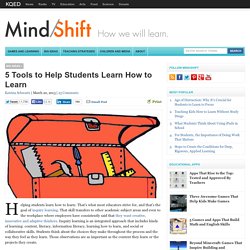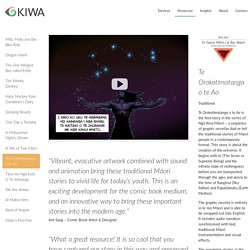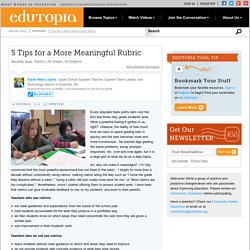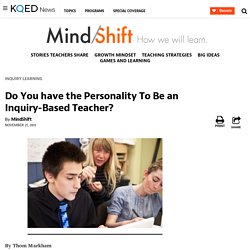

5 Tools to Help Students Learn How to Learn. Helping students learn how to learn: That’s what most educators strive for, and that’s the goal of inquiry learning.

That skill transfers to other academic subject areas and even to the workplace where employers have consistently said that they want creative, innovative and adaptive thinkers. Inquiry learning is an integrated approach that includes kinds of learning: content, literacy, information literacy, learning how to learn, and social or collaborative skills. Students think about the choices they make throughout the process and the way they feel as they learn. Those observations are as important as the content they learn or the projects they create. “We want students thinking about their thinking,” said Leslie Maniotes a teacher effectiveness coach in the Denver Public Schools and one of the authors of Guided Inquiry: Learning in the 21st Century.
Persuasive%20techniques.pdf. Te Whata Raki. Milly, Molly Maori Library. Te Orokotīmatanga o te Ao “Vibrant, evocative artwork combined with sound and animation bring these traditional Māori stories to vivid life for today's youth.

This is an exciting development for the comic book medium, and an innovative way to bring these important stories into the modern age.”Ant Sang – Comic Book Artist & Designer“What a great resource! It is so cool that you have captured our story in this way and preserved it. Amazing graphics - they really bring it to life! Ka mau te wehi! “Review on the App Store"I am a Chinese, always wanted to know a bit more about Maori culture and its history. Te Orokotīmatanga o te Ao Traditional Te Orokotīmatanga o te Ao is the first story in the series of Ngā Atua Māori – a sequence of graphic novellas that re-tell the traditional stories of Māori people in a contemporary format. The graphic novella is entirely in te reo Māori and is able to be swapped out into English. Features. Online games for learning Māori language.
5 Tips for a More Meaningful Rubric. Sarah Wike Loyola , Upper School Spanish Teacher, Spanish Team Leader, and Technology Mentor in Charlotte, NC Posted 06/08/2015 12:26PM | Last Commented 07/06/2015 2:30PM Every educator feels pretty darn cool the first few times they grade students' work.

What a powerful feeling it ignites in us, right? However, the reality of how much time we have to spend grading sets in quickly and the task becomes more and more monotonous. Genius Hour - Scaffolding for those who can't settle - The 6L Team- So introducing Genius Hour has been an absolute hit in my class.

The kids are getting right into it! The level of flow and collaboration in the classroom is simply amazing! However, Genius Hour has been a bit messy in the first few sessions (I've read that this is to be expected!). For some kids Genius Hour has been a hard concept to grasp. The freedom to choose to look into something became too much for some students and they had trouble settling on a topic. Growth Mindset Video.
Growth Mindset Animation. 5 Tools to Help Students Learn How to Learn. Do You have the Personality To Be an Inquiry-Based Teacher? By Thom Markham So far, the challenges of transforming education into a system capable of inspiring students to become skillful, creative, knowledgeable problem-solvers fall into familiar territory: What types of curriculum, standards, skills, strategies, and adaptations to classroom teaching methods will be necessary to do this?

But it’s likely these will prove to be secondary questions. As education crosses the divide between a transmission model and an inquiry model, a more pressing issue will be apparent: How do we identify, attract, nurture, and train teachers who have an “inquiry-friendly” personality? The issue already is in view. When a teacher comes out from behind the lectern, leaves the front of the room, kneels beside a student to coach them through a problem, offers feedback designed to promote confidence and perseverance, and becomes a true partner in the learning process, the relationship between teacher and student automatically shifts. These are trainable skills. Reinventing School From the Ground Up For Inquiry Learning. By Thom Markham A grave miscalculation exists in the minds of many educators: That inquiry-based learning, project based learning, and 21st century competencies can flourish in industrial model schools.
Under this world view, the inquiry goals of the Common Core State Standards are “strategies” to be added to the existing list of classroom techniques, while skills like collaboration, communication, or creativity can be taught despite 43-minute periods, desks in rows, and pacing guides set in stone. In other words, reaching the top of Bloom’s Taxonomy is important, but less so than maintaining regimental order. But what we know—from industry and neuroscience—is that organizational structure, environment, and human performance are deeply intertwined.
It is inevitable that schools must be completely redesigned if society wants to tap the wellsprings of creativity and exploration that the industrial system subdues. This redesign issue looms large. But a historical moment has arrived. Creating Classrooms We Need: 8 Ways Into Inquiry Learning. If kids can access information from sources other than school, and if school is no longer the only place where information lives, what, then happens to the role of this institution?

“Our whole reason for showing up for school has changed, but infrastructure has stayed behind,” said Diana Laufenberg, who taught history at the progressive public school Science Leadership Academy for many years. Laufenberg provided some insight into how she guided students to find their own learning paths at school, and enumerated some of these ideas at SXSWEdu last week. 1. BE FLEXIBLE.